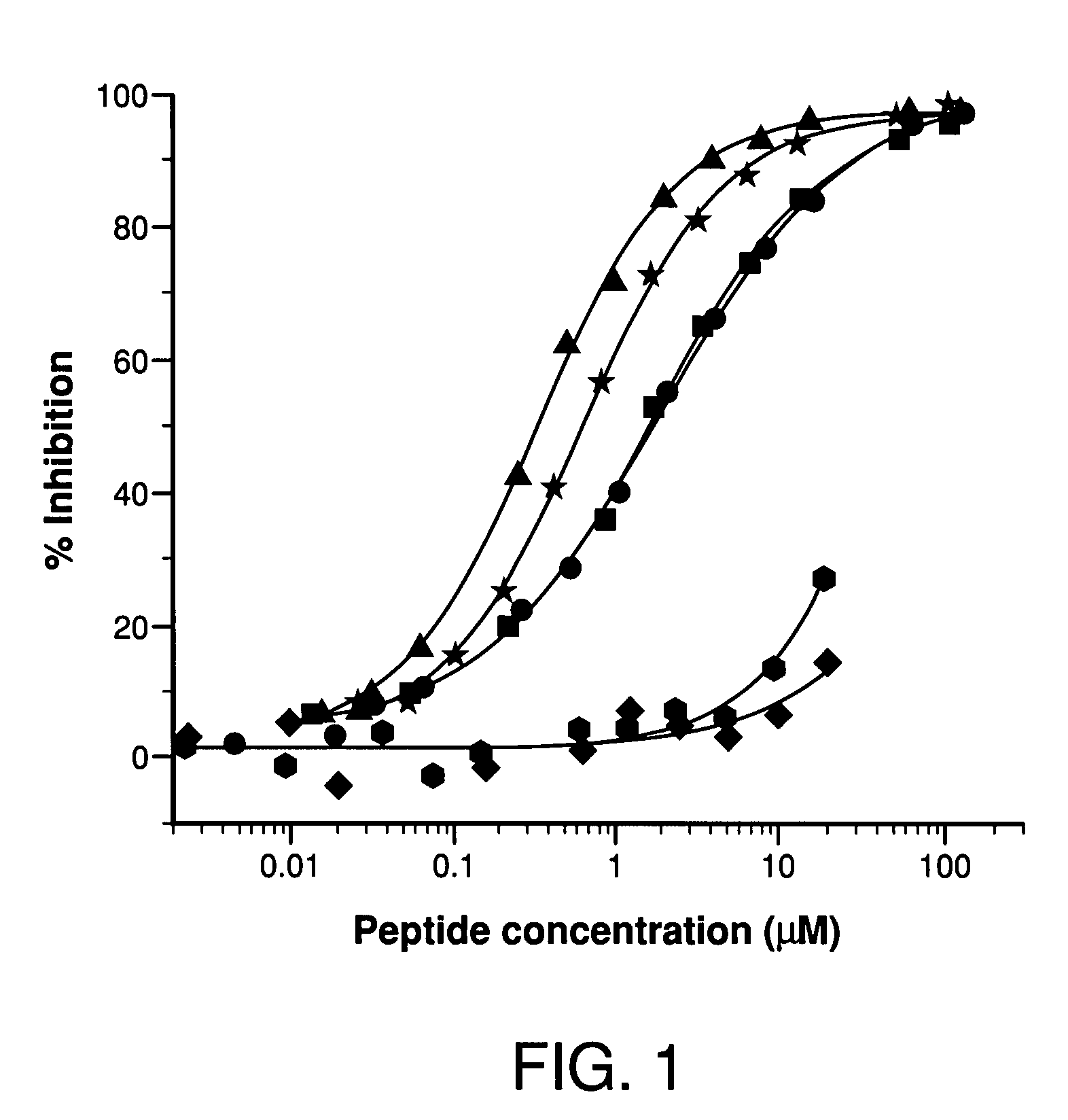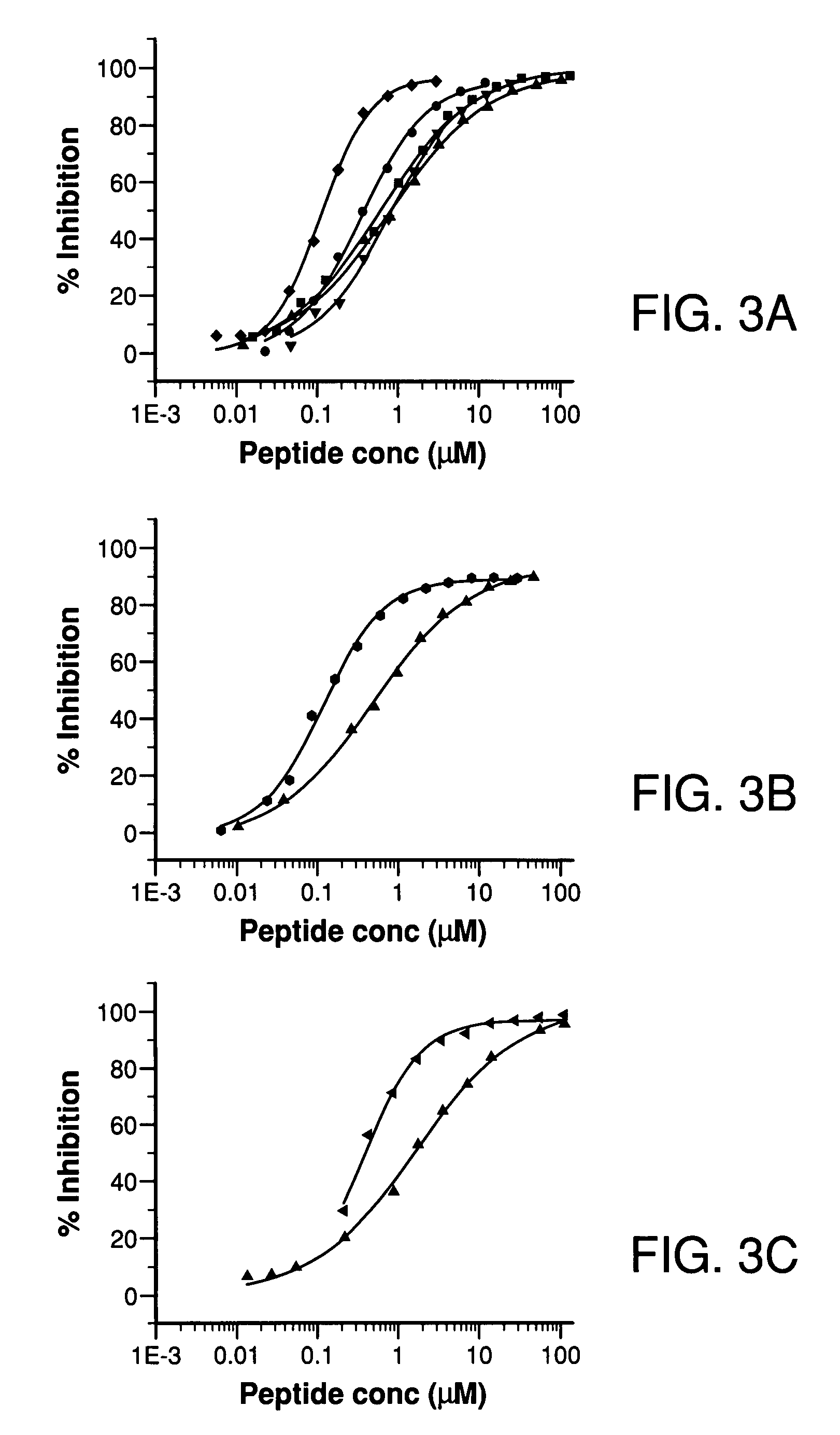Potent compstatin analogs
a technology of compstatin and analogs, applied in the field of complement cascade activation, can solve the problems of host cell damage, low activity or toxic, and the assembly of the membrane attack complex, and achieve the effect of improving the complement-inhibiting activity
- Summary
- Abstract
- Description
- Claims
- Application Information
AI Technical Summary
Benefits of technology
Problems solved by technology
Method used
Image
Examples
example 1
Bacterial Expression of Compstatin
[0085]A compstatin analog with the following sequence, NH2-GICVWQDWGAHRCTN-OH (“G(−1) / V4W / H9A / N14”) (SEQ ID NO:15) was expressed in fusion with chitin binding domain and the DnaB intein (New England Biolabs, Beverly, Mass.). Guided by the peptide sequence and the codon usage for E. coli the following genetic code was used to generate a synthetic gene for this peptide with the following sequence:
[0086]
(SEQ ID NO: 29)5′ATTTGCGTTTGGCAGGATTGGGGTGCGCACCGTTGCACCAATTAA3′
[0087]To clone the synthetic gene into the pGEM-T vector, a 5′ flanking region containing a SapI site and 3′ flanking region containing a PstI site were designed. To construct the synthetic gene, the four overlapping oligonucleotides shown below were designed using DnaWorks software and synthesized at Invitrogen Inc. (Carlsbad, Calif.):
[0088]
(SEQ ID NO: 30)5′GGTGGTGCTCTTCCAACGGTATTTGCGTTTGGCAGGA3′(SEQ ID NO: 31)5′TTGGGGTGCGCACCGTTGCACCAATTAACTGCAGG3′(SEQ ID NO: 32)3′CAACGTGGTTAATTGACGTCCGC5...
example 2
Expression of Tryptophan Analogs of Compstatin In E. coli
[0093]To express compstatin analogs containing tryptophan derivatives, the pTWIN1-compstatin clone was transformed into the ER2566 Trp 82 auxotroph. Expression was carried out in M9 minimal medium supplemented with 1 mM L-tryptophan as described above. Cells were grown to an OD600 0.8-1.0, then collected by centrifugation and resuspended in fresh minimal medium containing 2 mM of the desired tryptophan analog(s): 5-fluoro-tryptophan, 6-fluoro-tryptophan, 7-aza-tryptophan or 5-hydroxy-tryptophan. The expressed compstatin analogs were further purified as described in Example 1.
example 3
Peptide Synthesis
[0094]Peptide synthesis and purification was performed as described by Sahu et al., 1996; Sahu et al., 2000; and Mallik et al., 2005. Briefly, peptides were synthesized in an Applied Biosystem peptide synthesizer (model 431A) using Fmoc amide resin and standard side chain protecting groups. Peptides were cleaved from the resin by incubation for 3 hours at 22° C. with a solvent mixture containing 5% phenol, 5% thioanisole, 5% water, 2.5% ethanedithiol, and 82.5% trifluoroacetic acid (TFA). The reaction mixture was filtered through a fritted funnel, precipitated with cold ether, dissolved in 50% acetonitrile containing 0.1% TFA, and lyophilized.
[0095]The crude peptides obtained after cleavage were dissolved in 10% acetonitrile containing 0.1% TFA and purified using a reverse phase C-18 column (Waters, Milford, Mass.). Disulfide oxidation was achieved by an on-resin cyclization method using the reagent Thallium (III) trifluoroacetate. This method eliminates the dilute ...
PUM
| Property | Measurement | Unit |
|---|---|---|
| molecular weight | aaaaa | aaaaa |
| molecular weight | aaaaa | aaaaa |
| concentration | aaaaa | aaaaa |
Abstract
Description
Claims
Application Information
 Login to View More
Login to View More - R&D
- Intellectual Property
- Life Sciences
- Materials
- Tech Scout
- Unparalleled Data Quality
- Higher Quality Content
- 60% Fewer Hallucinations
Browse by: Latest US Patents, China's latest patents, Technical Efficacy Thesaurus, Application Domain, Technology Topic, Popular Technical Reports.
© 2025 PatSnap. All rights reserved.Legal|Privacy policy|Modern Slavery Act Transparency Statement|Sitemap|About US| Contact US: help@patsnap.com



